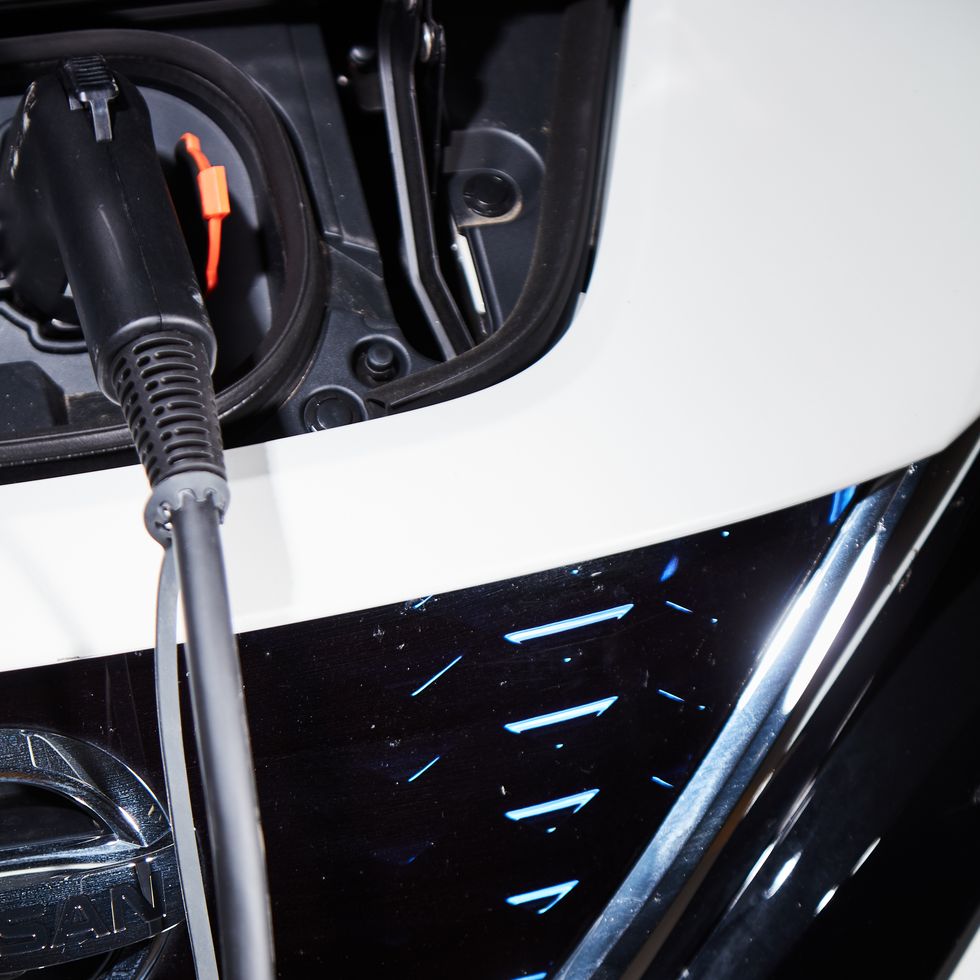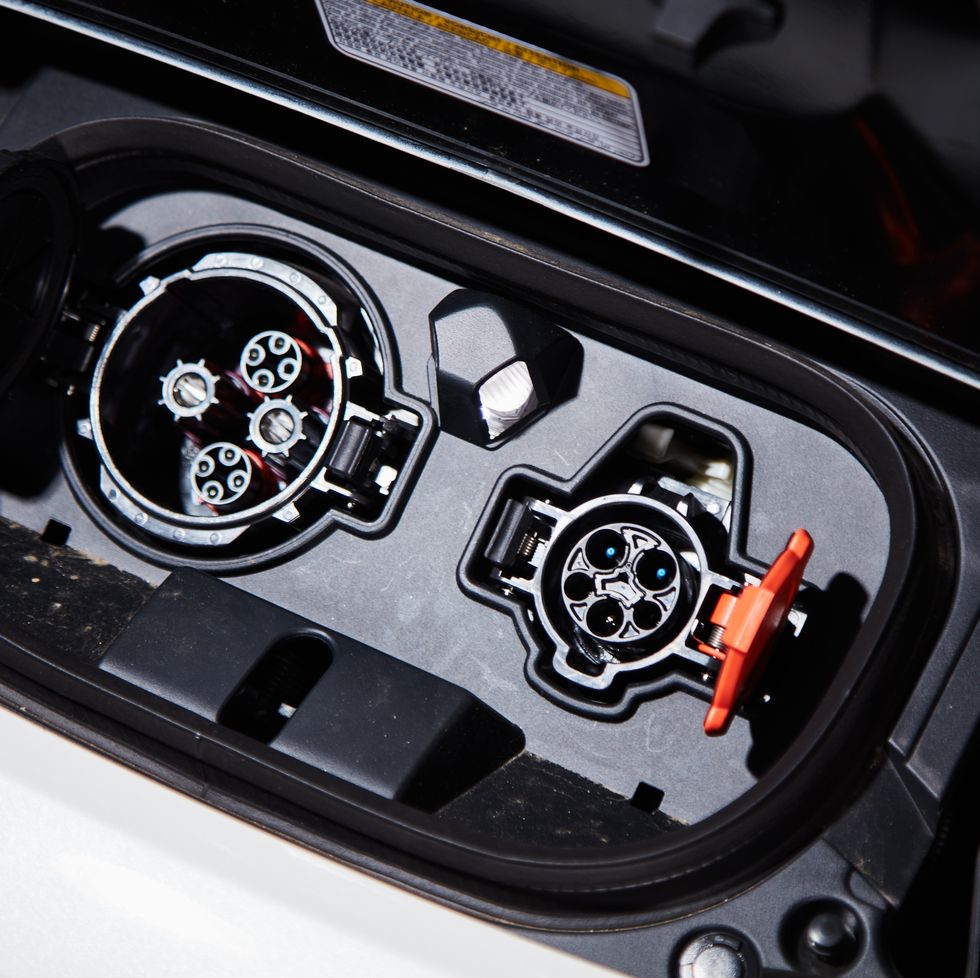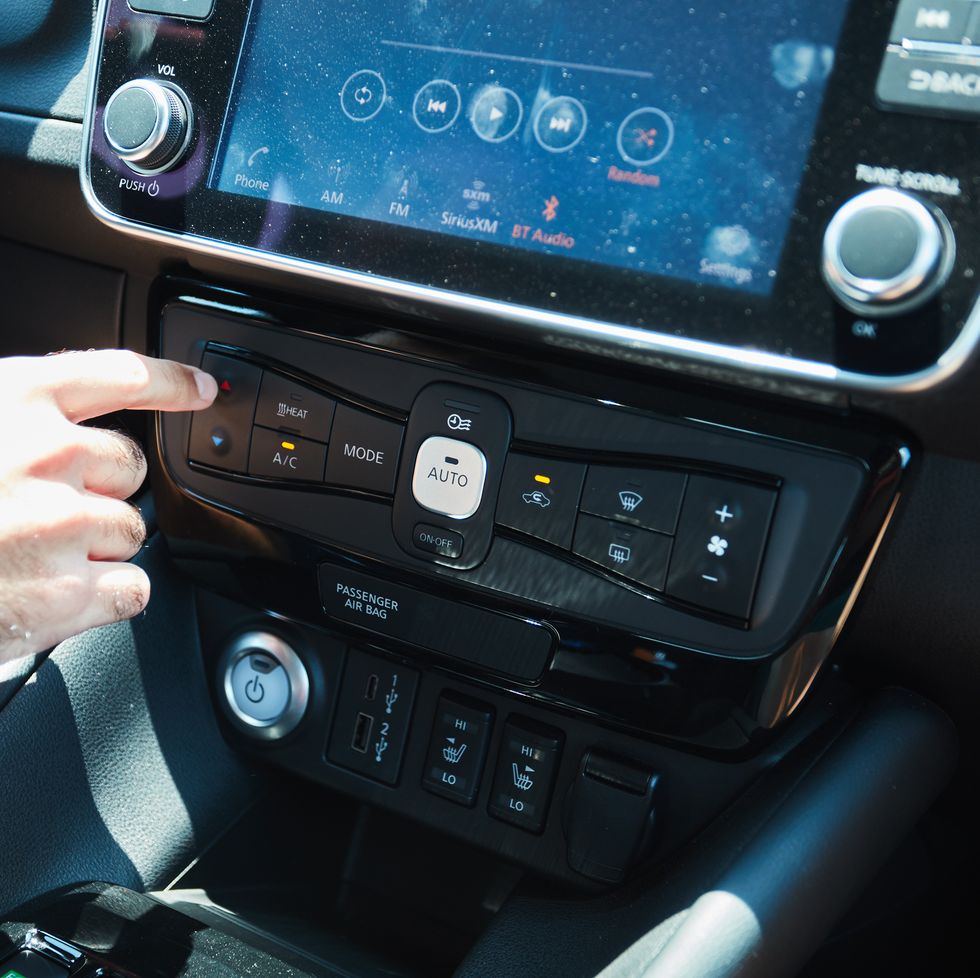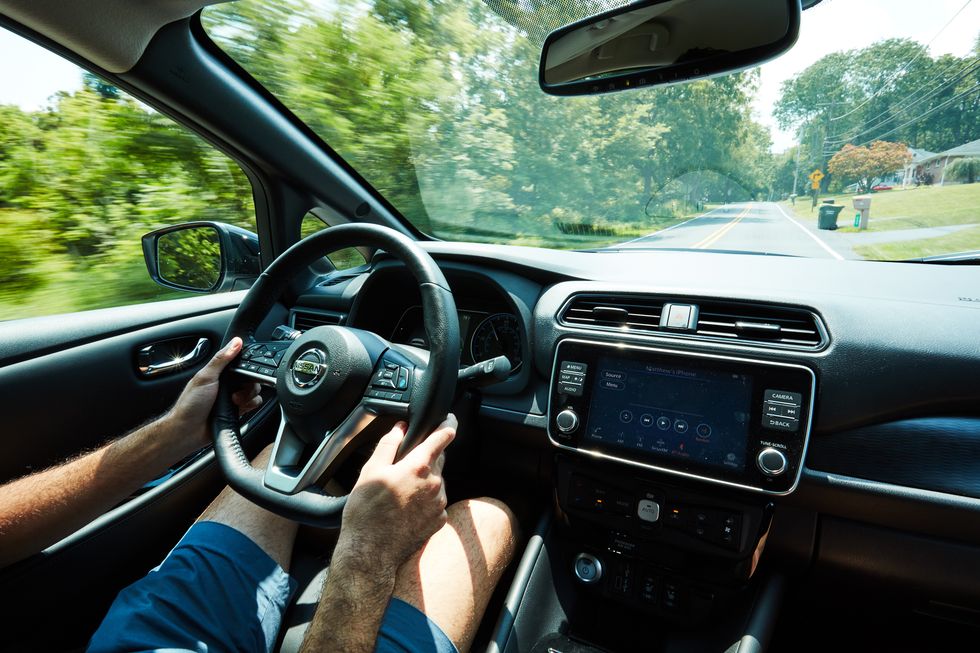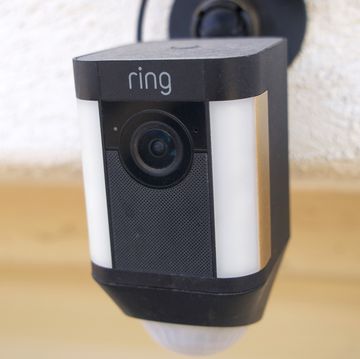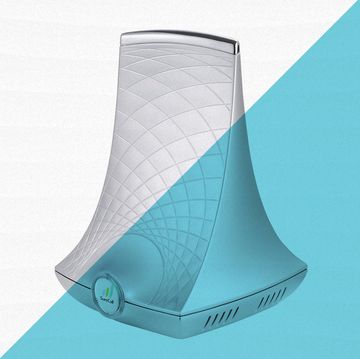The Takeaway
Despite being an evolution of the first mass-produced EV to rock down electric avenue, the 2021 Nissan Leaf Plus faces some fierce competition. At a price point of $45,930, our big-battery SL Plus test car slots in with other EVs like the base Tesla Model 3, Volkswagen ID.4, and Kia Niro. Even with Nissan being the elder statesman, its latest and greatest package can’t compete with any of these vehicles when it comes to range, power, and even charge times.
- Nissan’s ProPilot Assist driver aid makes highway journeys much easier.
- Mid-range acceleration from 30-50 mph is surprisingly crisp.
- The cabin is put together really well, with no squeaks or rattles to report.
- The steering feel was extremely muted at any speed.
Specs
- Base price: $43,970 ($45,930 for the SL Plus as tested)
- Front Motor: 160 kW AC synchronous electric motor
- Battery: 62 kWh
- Range: 226 miles
- Power: 214 hp, 250 lb-ft
- Zero to 60: 6.7 sec
- Charge time (home charger, zero to 100 percent): 7.5 hours
- Charge time (150-kW fast charger, zero to 80 percent): 40 minutes
- MPGe: 111 combined, 123 highway, 99 city
What’s In A Name?
Despite Tesla’s current domination of the EV marketplace, it’s important to mention that Nissan built the first affordable electric vehicle in 2010–the Leaf. Coming into the 2010 market with a starting MSRP of $32,780—$25,280 with the EV tax credit—it was propelled by a 23-kilowatt-hour battery that promised 100 miles of range. Setting the stage as an affordable electric vehicle that people actually wanted to buy, the Leaf persuaded other automakers to wade further into the EV waters. The question remains if the improvements to the latest model are sufficient to keep up with that ever-growing competition.
With five days to put the Leaf through its paces, I had plenty of time to get a feel for its quirks and idiosyncrasies while using it for my everyday driving. Throughout my testing, I took Nissan’s EV through everything from wide-open highways to the backroads and tight city streets surrounding the Popular Mechanics office in Easton, Pennsylvania.
Range, Speed, and Charging
While Nissan was first to enter the market with its definitive EV, the competition from other OEMs has since stepped up significantly. With a recent refresh in 2017, the Nissan Leaf received an updated powertrain, offering up 226 miles of range. However, it probably won’t surprise you to hear that the $39,990 base Tesla Model 3’s range of 263 miles is class-leading in this sub-$50,000 price bracket. Other comparable vehicles include the $41,190 Volkswagen ID.4 with 250 miles, and the $40,265 Kia Niro with 239 miles.
It’s important to note that motorists in the United States drive an average of just above 40 miles per day. So any range above the 200-mile mark is plenty. Having said that, I’m much more concerned about how that juice is delivered through the wheels and how that affects the driving experience.
Modern EVs are often considered the benchmark when it comes to acceleration. Electric motors offer up instant torque at low speed, which generally equates to blistering 0-60 times. However, thanks to the single 160-kW motor driving the front wheels and eco-friendly tires–215/50R17 Michelin Energy Savers–that favor rolling resistance over performance, the Leaf puts down a conservative 0-60 mph at 6.7 seconds. Compared to others in its category, the Volkswagen ID.4 is slowest to 60 mph at 7.6 seconds, followed by the Kia Niro at 6.2 seconds, and the base Tesla Model 3 at 5.3 seconds. It truly shined from 30-50 mph, where the zing from the electric motor properly puts you in the back of your seat. Even for someone like me who owns a manual Volkswagen Golf GTI, the Leaf’s punchy mid-range acceleration never failed to put a smile on my face when merging onto the highway and shooting gaps around the city.
When it comes time to top up the batteries, it’s clear that electric technology is still miles ahead of the infrastructure. Thankfully, the Leaf slots into the existing Charge Point stations, of which there are plenty here in eastern Pennsylvania. However, the lack of fast-charging points means the slower 6.6-kW system is still no match for the convenience of gas stations. During my weekly trip to the grocery store, with a stop at Chipotle—a journey of roughly 35 miles—I had the vehicle plugged in for the better part of an hour and a half to top up the batteries, which was good for an additional 20 miles of range. Having said that, I’d wager that buyers will most likely use the 110-volt trickle charger or 220-volt wall unit to plug in overnight at home—a luxury that isn’t widely available to many apartment dwellers like myself. Without access to a permanent set-it-and-forget-it solution, the lack of a rapid and easy way to add range becomes a much more critical issue. Sure, some apartment complexes are adding fast charging points, but they remain few and far between.
Autonomous Systems
Much like other driverless systems, Nissan’s ProPilot Assist is a great tool for getting through long road trips but far from perfect. Autonomy is rapidly becoming an automotive buzzword, but it’s important to note that these systems are still very hands-on. For those not familiar, the vehicle will keep you in your lane and at a safe distance from the car ahead. However, ProPilot keeps track of hand-to-wheel contact and will chime in and disengage if it notices you’ve gone hands-free.
I commend Nissan for sending one of its employees around the worst traffic jams in the United States to gather data for ProPilot Assist in stop-and-go traffic. This involved them sitting through 64 gridlock traffic jams in Los Angeles, Washington, Detroit, Pittsburgh, Baltimore, and San Francisco. This extremely valuable data went into the current system, which allows equipped vehicles to sit stationary in traffic for 30 seconds before disengaging. Despite this research, I never fully trusted the system in those conditions. Call me old fashioned, but it was unnerving to be barreling toward a stopped car, having to convince myself that ProPilot would apply the brakes. I didn’t feel like a daredevil 1940s fighter jet test pilot with the system engaged, but I still felt the need to anticipate how ProPilot would react to vehicles up the road. The experience was comparable to spotting someone at your local gym that you’ve never met. You have some idea of what’s going to happen, but there’s still some level of doubt and uncertainty. Having said that, just about any autonomous system will take some getting used to before learning its idiosyncrasies. There were more than a few instances where the system was misled by new lanes showing up and disappearing. This involved the car tending to drift into other lanes without immediately disengaging or sending any warnings.
Thankfully, the Leaf’s driver aids don’t end with just ProPilot. With the onboard sensors that make autonomous technology possible, you’ll also have access to adaptive cruise control, lane-keep assist, and automatic braking. Once your journey comes to an end, the Leaf Plus also has a 360-degree top-down camera system for parking, giving you a birds-eye view around the car. It’s useful tech for parking in tight spots but didn’t initially inspire 100 percent confidence. However, after a couple of attempts, the front and rear proximity sensors were a great addition for using all of the available space during a parking maneuver, and the side view was useful for getting close to the curb without scuffing the wheels.
Interior
Unlike its EV-producing compatriots, Nissan didn’t fall victim to the current trend of massive infotainment screens. The Leaf Plus features a full-color, eight-inch display–with compatibility for Apple Car Play and Android Auto–providing a good amount of real estate without being too distracting. The smaller screen leaves plenty of room for tactile buttons and knobs on the center console. For some reason, we see many automakers entering the EV market looking to rid the cabin of any and all tactility. While I understand that digital controls are easier on the eyes and clean up the interior, they aren’t always user-friendly.
The steering wheel offers similar functionality, with buttons to engage ProPilot Assist, select music, and make phone calls. The only glaring omission was a play/pause button, which proved to be a nuisance for someone like me who relies on Spotify as their personal DJ. Ergonomically, the wheel felt good in my hands, but the button layout wasn’t incredibly intuitive–it took a couple of days for me to get accustomed to the controls. Aside from the feel, the steering wheel wasn’t very communicative through the corners. While I could place the car where I wanted, the wheel remained extremely light at any speed and never really loaded up. Sure, steering feel isn’t all that important for a vehicle of this type, but it becomes critical for driving in winter conditions.
Visibility wasn’t a strong point of this car, either, which took me by surprise after I initially saw the amount of glass in the Leaf Plus’s greenhouse. Despite the elevated driving position (even the seat’s lowest setting is fairly high up), the A, B, and C pillars were all quite large, which inhibited my visibility. While the obstruction was manageable on the highway, squeezing through tight city streets with pedestrians and parked cars required equal parts concentration and bravery.
Up front, the Leaf offers up a comfortable experience, but the same can’t be said of the rear seats. The sloping roofline looks great from the exterior yet robs critical headroom from people sitting in the back—leaving only 37.3-inches of airspace. I’m just shy of six feet tall, and my head barely cleared the ceiling. To offer some perspective, the VW ID.4 is class-leading in this area at 38.4-inches. Thankfully, legroom inside the Leaf was much better, with 33.5-inches to work with and stop you from cramping up during a long journey.
Quality Control
While visibility may not be the Leaf’s strong point, the fit and finish of the interior was very impressive. For all the benefits of electric cars, the sound of an internal combustion engine can do wonders to cover up pesky noises like squeaks, rattles, and vibrations. The lack of such a roar leaves EVs no room to hide when it comes to these types of sounds. I’m happy to say that while the interior doesn’t feature the flashiest of materials, I got the feeling that everything was built to high tolerances, and the lack of noise attests to that.
Many electric vehicles succumb to the endless pursuit of letting others know that they’re battery-powered. We often see this with front grille deletes, wacky names, and wheels that are styled at an 11 out of 10. While there’s a time and a place for this kind of pomp and circumstance, it’s refreshing to see that Nissan aimed for the Leaf Plus to be a great automobile first and foremost.
The biggest issue I have with the new Leaf is the price point. Our top-of-the-line, big-battery model came in at $45,930, which put it in the same ballpark as vehicles like the base Tesla Model 3, Volkswagen ID.4, and Kia Niro—three vehicles that outperform the Leaf in nearly every measurable aspect. Sure, it’s a step above the previous generation, but Nissan needs to price down or option up to stay with the heavy hitters in such a competitive industry. While the Leaf doesn’t quite measure up to the competition, it’s still a great option for short-range commuters looking to make the transition from gas to electric. If driver aids and going the distance aren’t super important to you, I’d recommend you go for the more affordable S model—$31,670 MSRP— which comes with a smaller 40-kWh battery, giving you 149 miles of range.
Matt Crisara is a native Austinite who has an unbridled passion for cars and motorsports, both foreign and domestic. He was previously a contributing writer for Motor1 following internships at Circuit Of The Americas F1 Track and Speed City, an Austin radio broadcaster focused on the world of motor racing. He earned a bachelor’s degree from the University of Arizona School of Journalism, where he raced mountain bikes with the University Club Team. When he isn’t working, he enjoys sim-racing, FPV drones, and the great outdoors.


